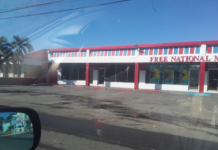
Press Conference on New Providence Red Water Issues
By Bradley B Roberts
Chairman Water & Sewerage Corporation
30th December 2013
STATEMENT:
As you are acutely aware, the Water and Sewerage Corporation has had challenges with the quality of water supplied to the New Providence water system. The challenges, which were primarily related to water shortages to red or rusty water throughout the system, became more pronounced with the commissioning of the expansion of Blue Hills reverse osmosis plant, as our New Providence based customers increasingly reported higher incidences of red water supplied to their homes.
This tremendous public outcry, which has been repeatedly reported in the press and discussed over the internet in the various social media, has decried the poor quality of drinking water, bath water and washing water.
While a number of attempts were made to get to the root of the rusty water woes, the Corporation’s traditional view, as espoused by its management, was that the root cause of the ‘red’ (rusty) water was the ‘old pipes’ in the system.
Under this premise, strategies were formulated to address this vexing problem. These included:
1. Allocation of significant monies under the New Providence Road Improvement Program to replace ‘old pipes’ in key areas throughout the island;
2. Continuous flushing of the water distribution system in areas where red water incidences were more pronounced;
3. A filter purchase and distribution program to customers who officially lodged a complaint with the corporation.
The Corporation’s current Board of Directors, however, in the face of the huge public outcry and armed with very credible information that was brought to their attention, refused to accept the rationalization that ‘old pipes’ were the ‘cause’ of the rusty water problems. In this vein the Board, in its wisdom, prudently commissioned an independent forensic review of the Corporation’s water supply and delivery program, to determine the root causes of the rusty water woes and identify possible remedies.
With a full appreciation of the very public implications of this ongoing problem, the Board sought to engage an eminently qualified international expert to conduct the forensic audit. In this vein, the Corporation subsequently engaged Ian C. Watson, PE, of RosTek Associates, Inc., who was ably assisted by Steven J. Duranceau, PhD. PE., of Duranceau Consulting Services, LLC.
We have invited you the members of the press here today, to inform you of the progress we have made in our efforts to address this most vexing and long term problem and share highlights of the forensic review which was most recently officially presented to the Corporation’s Board and Executive Management Team.
Review Highlights
The highlight of the forensic review was the fact that a critical amendment was made to the Blue Hills Plant expansion contract, providing a loophole for the contractor by way of reduced water quality parameters and penalties. The forensic consultants have advised the Board & Management of the Corporation that, as a result of this amendment, significant financial benefits have accrued to the contractor for the provision of reduced water quality, at a real cost to WSC in terms of its flushing exercises, accelerated pipe replacement program, filter distribution program and its brand.
Most notably, with the exception of the changes brought on board by a new government, i.e., new Board and Minister(s), all of the players were basically still in place. The engineers of record for the Blue Hills Plant Expansion contract, CDM Engineers, were the same consultants of record for the original Blue Hills Plant contract, which was awarded under my watch as Minister responsible for WSC. The internal project management leadership was also still intact.
The consultants at that time made it patently clear how important the water quality provision was, specifically the LSI requirements, in light of the state of WSC’s delivery system. It is therefore inexplicable that, less than five years later, they would have removed or agreed to the removal of this critical provision.
Further the report also highlights that the corporation’s management was aware of the removal of this vital requirement but the auditors could not confirm if they (Management) were aware of the implications of moving it. However, there is nothing on record to show that any objections were lodged.
Terms of Reference
The Terms of Reference for the engagement, which began in April and was recently concluded, included the following:
· A review of the original and expansion contracts for the Blue Hills Sea Water Reverse Osmosis (SWRO) plant, to specifically address contractual requirements for:
o post-treatment of the SWRO permeate to avoid red water issues in the distribution system including requirements for meeting and maintaining a specific Langelier Saturation Index (LSI);
o historic water volumes delivered, and delivered water quality;
· A representative sample review of prior payment vouchers for accuracy and contract compliance. Identify prior contractual compliance issues. Recommend possible financial mitigation measures available to WSC;
· Recommendations for contractual language to strengthen the existing and expansion contracts, including a methodology to assess damages for failure(s) to meet contractual finished water quality requirements;
· Preparation of a detailed assessment of the Blue Hills facility, including any recommendations for increased maintenance and/or repair;
· Review of contractor’s Maintenance History and Scheduled Maintenance Plans and identification of shortcomings or potential issues, if any;
· Recommend additional contractual language if required to strengthen the maintenance sections of the existing and expansion contracts;
· Review of the history of red/rusty water incidents in the distribution system;
· Correlation of occurrences with coincidental finished water quality, including LSI, being delivered to the distribution system;
· Review of WSC s response actions, proposed additional mitigation actions, and develop (with WSC engineers) a program of corrosion inhibitor application and other actions designed to resolve the customers red water issues, including pricing comparisons of alternatives. The program selected may be administered by the Contractor, or by WSC.
Key Report Findings:
Ø Prior to the introduction of desalinated seawater in 2006, ground water was barged from Andros;
Ø There is little doubt that the use of this water for many years caused a significant build-up of scale on the inside of the distribution piping as shown in the photographs of sections removed from the system;
Ø This water was mildly brackish, and contained considerable calcium hardness and bicarbonate alkalinity;
Ø Since the commissioning of Blue Hills 1 reverse osmosis plant, WSC has been plagued with red water complaints.
Ø The red water complaints that started with the startup of Blue Hills RO are almost certainly the result of re-solution of the internal pipe deposits built up over time by the barged water;
Ø When the expansion came on line in late 2011, coinciding with the cessation of barged water from the Arawak Key pump station, the number and severity of the complaints increased dramatically;
Ø At this time the aggressive post treated desalinated water was being distributed in the old distribution system in Nassau, where it not only started re-dissolving the scale, but also it appears to have started to corrode the exposed ferrous piping;
Ø The current severe red water problems will continue unless major changes are made to post treatment;
Ø The red water is caused by a combination of re-solution of internal scale and corrosion of exposed ferrous pipe wall itself;
Ø The ongoing non-revenue water project is changing historic flow patterns in the distribution system as sections of the piping network are isolated for repair or replacement;
Ø Unless the water produced from Blue Hills is properly stabilized and an LSI of around +0.5 is maintained, the red water issue will remain;
Ø Since in our opinion the red water issue is not caused solely by corrosion of ferrous piping material in the distribution system, the addition of corrosion inhibitor alone will not solve the problem;
Ø Pipe replacement should continue where replacement occurs in those areas that have recurrent red water complaints;
Ø Improved management of post-treatment operations is required;
Ø Focus on improving and maintaining constant pH and provide adequate
alkalinity as the primary distribution system water quality objectives.
The report further highlighted the following quality and financial considerations that are directly correlated to the proliferation of the red water problem and other areas of concern:
· The reporting requirements stipulated in the existing water contracts on New Providence were not being adhered to – “While some of this information is provided on the monthly invoice, these weekly reports have not been received by WSC on a regular basis. The requirement in 7.5 for a monthly report summarizing the weekly reports can therefore not be in compliance”;
· There are no penalties, financial or otherwise, included in the contract language for failure to meet the minimum water quality requirements.
– The finished water LSI is required to be positive at all times for the original plant.
– Our preliminary evaluation of the water quality data indicates that for the most part this requirement has not been met, and it is our belief that this condition has led directly to the red water problems that have been plaguing WSC for many years;
· “The cost of mitigation to WSC has been high, both in remediation measures such as the supply and maintenance of filters for the consumers, but also in staff time, and water lost during the flushing operations.”
· “Other examples of water quality parameters that have not been continuously met are the finished water chlorine residual, and the chloride content of the finished water.”
In light of all the above and the United Nations recent assertion that water should be considered as vital to national security as a country’s defense, the Board is of the decided view that it is in the best National interest to properly educate the public with the problem, how it evolved and the steps this government will take to redress.
The task that the Board is now faced with, in light of the fact that this problem will not easily be resolved, is how to best improve the existing contract with the contractor. This will include the insertion of appropriate industry standard contractual language, to calculate penalties for water quality failures where WSC takes water that is not fully compliant with contractual quality standards, i.e., specifically residual chlorine, chlorides and LSI levels.
To assist with this exercise, WSC will engage the forensic consultants to coordinate the Corporation’s redress efforts, ensuring that the proper language, i.e., qualitative, punitive and financial, are included in the water contracts and to lead the imminent negotiations regarding possible reimbursements for ‘below minimum requirements’ supplies.
In the spirit of Accountability and Transparency, some person(s) must be held accountable for permitting the critical change to the contract for the Blue Hills Plant expansion project and the ensuing problems, which has led to the erosion of public confidence in the corporation.
The burning questions therefore has to be, “why did the government of the day allow a change in the contract, without a proper technical explanation?” Or more importantly why didn’t the Board or Ministers responsible seek an independent assessment on the probable implications of removing or altering contractual clauses that speak to water quality?
Member of the Press – please rest assured that this Board and Government will continually report the facts and the findings, as we move to eradicate this most vexing and costly problem.
The Forensic Report will be published on the Corporation Web-Site shortly. The cost of the review is not likely to exceed $50,000.







